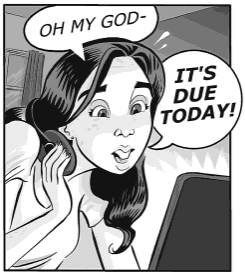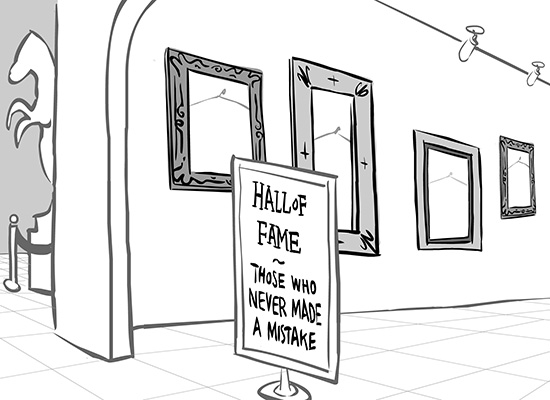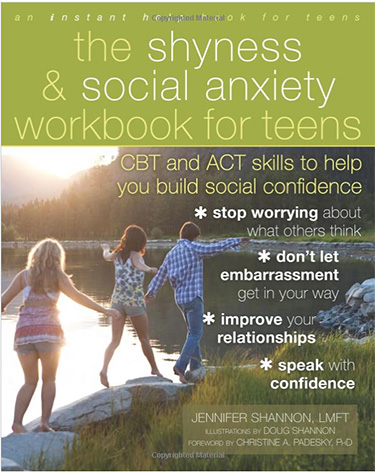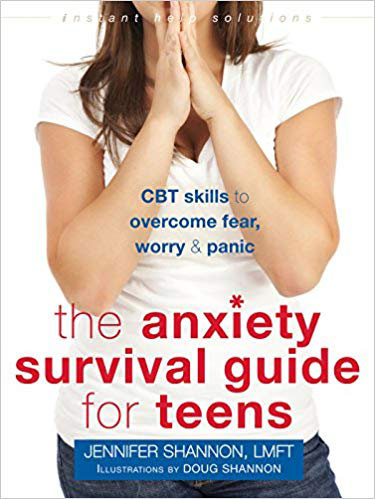Books For Teens

A Teen’s Guide to Getting Stuff Done: Discover Your Procrastination Type, Stop Putting Things Off, and Reach Your Goals
The Shyness and Social Anxiety Workbook for Teens: CBT and ACT Skills to Help You Build Social Confidence
The Anxiety Survival Guide for Teens: CBT Skills to Overcome Fear, Worry, and Panic
Why I Wrote These Books

Jennifer Shannon, LMFT and her daughter Rose
I will never forget the morning I pulled the covers off my daughter, telling her in my firmest voice that she had to get out of bed NOW. From the beginning of sixth grade it had been a struggle, but with a firm hand, I was able to get Rose out of bed and off to school. But this morning we’d hit a wall. She looked at me with genuine dread. “Mom,” she said, “I would rather die than go to school.”
My beautiful daughter had developed severe social anxiety disorder. On her “good” days at school she survived by avoiding social interactions, often hiding in the bathroom during recess and lunch breaks. On her worst days she had full-blown panic attacks and went to the office complaining of stomach aches and asking to be sent home. While there was nothing physically wrong with her, I knew her distress was real. And as a parent, I was suffering too.
The reason I knew what was wrong with her is that I am a cognitive behavioral therapist who specializes in treating children and adults with anxiety disorders. I knew how treatable her condition was and I was aching to help her, but predictably, she didn’t want her mother to double as her therapist. We live in a midsize town, but it can be very hard to find a cognitive behavioral therapy (CBT) therapist who is well trained in the treatment for anxiety. I sent her to two different therapists, neither of whom were helpful to her. I knew from working with hundreds of families that finding the right kind of treatment can be a frustrating problem. We decided to try to work together on the problem, and to try not to get caught up in the roles of therapist and client.
I explained to her that the active ingredient for the treatment of social anxiety disorder is gradual exposure to feared situations. Rose knew her feared situation was school, and she truly wanted to try, but her anxiety felt overwhelming. We needed to lower the bar somehow. Perhaps, we thought, she could do better in a smaller school. Disclaimer: changing schools isn’t something I’d recommend for my social anxiety clients, but it’s what we did, so it’s part of our story.
School Accommodations for Social Anxiety
Before her first day at her new school, I met with the principal, the school counselor and the teacher to explain social anxiety disorder to them. They’d seen plenty of it before, but they needed to know the importance of gradual exposure. The accommodation we agreed on was to pair Rose with a classmate who would show her around and help orient her to her new school. If she had a panic attack at school, she would have permission to go to the office until she calmed down, but would need to stay at school. The stage was set.
Gradual Exposures
It was over ten years ago, but I remember driving Rose to her new school as clearly as if it happened yesterday. We were both nervous—she about a new school, and I about whether our plan would work. Would she get out of the car? Would she stay at school? Would she keep hiding in the bathroom during lunch and breaks?
To get her started interacting with new peers, I made a modest proposal. If she smiled and said “Hi” to three students that day, we’d stop for ice cream on the way home. She agreed, but without much confidence or enthusiasm. I had all day long to wonder whether three was too many. Maybe just one would be enough of a challenge.
But Rose did it! She made it through that first day, and we both enjoyed a well-deserved stop for ice cream that day. From then on, every morning on the way to school we thought up new exposures for her to do that day. Asking others for their email addresses developed into actually emailing someone, which developed into getting phone numbers, and eventually, actually making a phone call. Over time her anxiety decreased, and she made some friends.
Rose’s social anxiety didn’t disappear. It continued through middle school and into high school, but it was no longer a social anxiety disorder. Rose was able to function despite her anxiety. She understood that the only way through it was to continue to face her fears over and over again, and every day she attended school she did just that.
At age nineteen, Rose made a beautiful YouTube video about her experience with social anxiety. If you’d like to hear it in her own words, click on the link. Then share it with someone you know who is struggling with this very common and very treatable disorder.
Epilogue
Rose has always been an avid reader, and when she developed social anxiety, I wanted to buy her a book for teens about this disorder. To my surprise, there were none. Social anxiety is the most common type of anxiety there is, and the typical age of onset is adolescence. This is what inspired me to write my first book, The Social Anxiety Workbook for Teens. I did not want other teens and their parents to suffer thinking they were alone and not knowing how to help themselves.
Cognitive Behavioral Therapy…

Generalized Anxiety Disorder
Everyone worries, but people with generalized anxiety disorder worry more persistently and are overly concerned about things like health, money, work or school, natural disasters and relationships. Chronic worry and stress have been associated with intolerance of uncertainty, thinking what you don’t know could hurt you. People with generalized worry tend to spend excessive time trying to plan and predict what could go wrong to prevent bad things from happening.
Common symptoms experienced with people with generalized anxiety are:
- Difficulty sleeping
- Difficulty concentrating
- Frequent stomach aches and/or headaches
- Muscle tension
- Fatigue
- Irritability
Children with generalized worry are often concerned about their grades, getting in trouble of school and the health of their parents or themselves. They are often very sensitive to things they hear on the news and will worry about natural disasters or crime.
Cognitive-behavior therapy is an effective treatment for chronic worry and stress, helping them learn to tolerate uncertainty and live more rich and fulfilling lives.
Social Anxiety & Social Phobia
Social anxiety is the most common type of anxiety there is. We all want to be accepted, respected and have a sense of belonging. Most of us worry about making a good impression and being liked. However, with social anxiety this fear is blown out of proportion. People are overly concerned about doing or saying something that could be embarrassing and being judged and criticized by others. You may not want to be the center of attention, or worry that others may notice and judge you for showing signs of anxiety like blushing or sweating.
Social anxiety can interfere with developing friend or romantic relationships, completing school, and applying for jobs or promotions. You may have it in specific situations, like performing in front of a group or public speaking, or it may be generalized to starting conversations with people or going to social events. It usually develops in childhood or adolescence and continues into adulthood.
Typical situations that cause anxiety are:
- Starting or maintaining a conversation
- Appearing nervous to others or being observed blushing, sweating or shaking.
- Using a public restroom
- Participating in small groups
- Eating in front of others
- Giving a presentation
- Asking someone out
- Being observed by others
- Being the center of attention
Children and teens with social anxiety may avoid asking the teacher for help, answering questions in class, going to P.E., having their picture taken and oral presentations. Very young children may have what is called selective mutism, where they avoid talking in school and to people they are unfamiliar with, but have no problems speaking at home.
Cognitive-behavioral therapy is very effective in overcoming shyness and social anxiety. Using gradual exposure to feared situations and changing underlying beliefs about oneself, social anxiety can be mastered.
Listen to Jennifer Shannon’s podcast for the Anxiety and Depression Association of America on Teen Social Anxiety Disorder.
You can take the Liebowitz Social Anxiety Scale to self-assess your own social anxiety.
Obsessive Compulsive Disorder
We often talk about being obsessed with something, like a song, a food, a person. Though it is true that it may be hard to get your mind off of these things, they are not necessarily upsetting to think about. In the case of obsessive-compulsive disorder, or OCD, the obsessions always cause anxiety. OCD obsessions are intrusive thoughts, images or urges that you do not want to have and cause significant distress. The obsessions, unlike worries in generalized anxiety, can be a little strange, like wondering if you may have hurt someone accidentally, thinking something bad might happen if you don’t do or say something, worrying about your cloths being contaminated and getting you or someone you care about sick.
Most obsessions fall into these categories:
- Contamination, fears you will “catch something” or be poisoned by touching a surface or object
- Harm or aggression, thinking you caused or will cause physical or emotional harm to yourself or someone you care about
- Forbidden sexual or religious thoughts, that threaten your sense of being a good or decent person
- Symmetry or exactness, having a general sense of discomfort unless things are “just so,” or done in a certain way
Compulsions
Compulsions are the things you do to attempt to decrease the anxiety that the obsessions cause. They are repetitive behaviors or mental acts that you have a strong urge to do. They are unlike a normal routine, in that they take up more time than you would like them to. Much like obsessions, you may know they are excessive or unreasonable, but this does not make them any easier to resist.
Common compulsions are:
- Checking that you did not forget something, make a mistake, cause harm or turn something off.
- Cleaning or washing your hands or body, cloths or belongings, or using hand sanitizer
- Repeating like touching or tapping things, going in and out of doorways, blinking or body movements, rereading, erasing or rewriting things.
- Ordering or arranging things like having all your cloths color coded, things lined up at right angles, or your room or desk arranged in a certain way.
- Mental compulsions like making mental lists, using or avoiding certain numbers, words or phrases, repeating prayers, trying to remember things.
Treatment
Exposure and response prevention therapy (ERP) is a form of cognitive-behavioral therapy that has been shown to be highly effective in treating OCD. You can learn more about this type of therapy by listening to a Podcast with Dr. Jonathan Abramowitz, a leading expert in the treatment of OCD.
Panic Disorder & Agoraphobia
Panic Disorder
50% of all adults have experienced a panic attack at some point in their life. If you are experiencing frequent panic attacks that often occur out of the blue and you are afraid of having more, you may be suffering from panic disorder. The most common fears people with panic disorder have are a fear of dying, going crazy, and/or losing control.
The most common physical sensations people experience during a panic attack are:
- Feeling dizzy, light headed or faint
- Difficulty catching one’s breath
- Rapid, pounding or fluttering heart
- Tightness in one’s chest or throat
- Nausea or abdominal cramping
- Sweating, shaking and trembling
- Numbness or tingling
- Derealization (things don’t seem real) and/or depersonalization (thoughts and feelings seem unreal or not belonging to oneself)
Panic symptoms are similar to physical illnesses like heart attacks. People experiencing panic for the first time often go to the emergency room because they are worried they are having a heart attack. While panic attacks themselves are harmless, it is important to rule out an underlying illness that may cause panic like symptoms.
Agoraphobia
Agoraphobia is a big word that sounds scary and is often misunderstood. It is the fear of going to places or situations that you may have a symptom attack with no easy way to escape or get someplace you think of as safe. A symptom attack could be a panic attack, diarrhea, a sudden headache, nausea, loss of bladder control, or asthma. You can suffer from panic disorder with agoraphobia, which means you have panic attacks in certain situations as opposed to out of the blue. Common situations that people fear being trapped are:
- Cars, trains, and buses, tunnels, planes, boats
- Bridges
- Crowds
- Standing in line
- Being far away from bathrooms, hospitals, home.
Cognitive-behavioral therapy is an effective treatment for panic disorder and agoraphobia. It teaches people how to respond to physical sensations differently and slowly face the situations they have been avoiding allowing them to live more fully with less anxiety.
Phobias
Phobias are very common. In fact, most people have some type of phobia. Being frightened of things like insects, heights and needles is part of being human. But when this fear is extreme, preventing you from doing things you want to do or go places you want to go, you may have a specific phobia disorder.
Specific phobias can be about almost anything, in fact if you search on the internet for a list, there are literally hundreds! However here are some of the most common types:
- Animals: dogs, cats mice, rats birds, snakes, insects
- Things that occur in the natural environment: heights, water, thunderstorms, or lightening
- Situations and places: traveling in a car, plane, bus, train, or boat; closed-in spaces such as closets and tunnels
- Medical issues: injuries, blood, needles, dentists, doctors, hospitals
- Illness and bodily functions: vomiting, stomach flu, food poisoning, choking on pills or food, having a dry or closed throat, not being able to breath
One of the more common phobias that I treat is a fear of vomiting, which is technically called emetophobia. No one likes to throw up, but if you have this phobia your fear of vomiting is out of proportion. If people around you get sick, including family members, you may become extremely anxious that you will get the stomach flu. People with this phobia will often monitor their body carefully for signs of nausea. This, like other specific phobias can cause significant disruption in one’s life.
Cognitive-Behavioral Therapy (CBT) helps people to face their fears in a gradual and supportive way. CBT is one of the most effective treatments for phobias, most people report feeling significantly less fearful after only 12 sessions or less.
Separation Anxiety
Separation anxiety usually begins in childhood and relates to the fear of being away from a person one feel particularly attached to. For children this is usually parents, siblings, or a close relative and for adults it may be a spouse, a romantic partner, their child or a close friend. When separated, even for a few hours, one begins to feel anxious or on edge, worrying that something bad might have happened to the other person and that they will be alone forever.
When children have separation anxiety they often have trouble sleeping alone. They don’t like to be left with babysitters, and when away from a parent or attachment figure, they will often want to check in repeatedly. They may become panicked if a parent is even a few minutes late coming home or picking them up. The child often wants to know exactly where the parent is going to be at all times, sometimes even within their own home.
Children with separation anxiety often experience stomach aches, headaches, and sometimes even vomiting when anticipating or when separated from the person they are attached to.
Adults can have many of the same symptoms as children, not wanting to be alone at night, becoming distressed when their partner is away on a trip, checking in with the person repeatedly and panicking when the other person is late or does not respond to their calls or texts.
Cognitive behavioral therapy is effective treatment for separation anxiety. It focuses on helping people think more realistically and gain confidence being away from the person they are attached to.
Insomnia
Insomnia is extremely common, with over half of all adults experiencing it in their life time. Chronic insomnia can be a real problem, causing fatigue and low energy, difficulty concentrating, causing poor moods, and decreased performance at work or school. It is defined as disrupted sleep at least 3 nights a week for 3 months or longer. People with insomnia may have problems falling asleep, staying asleep, early morning wakening or restless sleep. People often begin dreading going to bed, feeling anxious and stressed about not being able to depend on whether you will sleep or not.
CBT-I, or Cognitive behavioral therapy for insomnia is a proven method to treat chronic insomnia and is aimed at changing sleep habits and sleep scheduling. It focuses on education about the different stages of sleep and understanding how your thoughts and behaviors have contributed to making this a chronic problem and how to change.
Listen to an interview with Jennifer Shannon about CBT-I for insomnia on Dream Talk Radio with Anne Hill.
Other
Post Traumatic Stress Disorder
Depression




